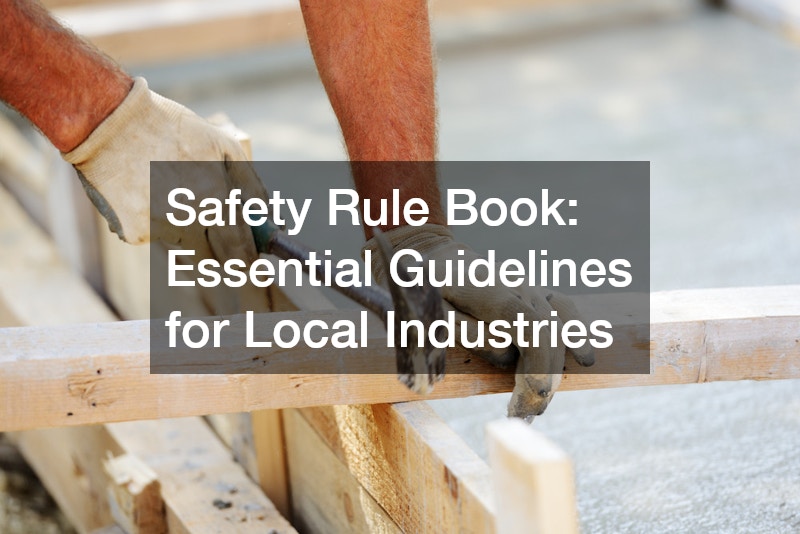
In various industries and professions, safety is of paramount importance not only for ensuring the well-being of workers but also for the efficiency and quality of the outcome. Whether it’s in local boat manufacturing, construction, or plumbing, following the correct safety guidelines is essential. Craftsmanship safety practices are detailed in safety rule books, which offer a comprehensive collection of best practices, procedures, and legal requirements. These books are a critical resource for businesses and individuals alike, helping them to minimize risks and promote a culture of safety. This article provides a detailed exploration of safe practices across various sectors, highlighting the importance of adhering to guidelines captured within each industry’s safety rule book.

Safe Practices for Craftsmanship
Local boat manufacturers adhere to stringent safety standards to ensure that their creations are not only functional but also safe for users. The safety rule book often includes guidelines covering everything from material handling and workspace cleanliness to emergency response procedures. Ensuring each component is crafted with precision and care is crucial, but so is maintaining a safe work environment for the craftsmen at work.
Training is imperative for craftsmen working with potentially hazardous tools and materials, emphasizing the need for continual education and adherence to updated safety protocols. Companies often integrate safety rule books into their training programs, reinforcing regulations and the importance of safety gear. This ensures increased awareness and preparedness among the workforce, reducing the probability of workplace accidents.
Furthermore, regular audits and safety drills foster a culture of safety among employees. These proactive approaches enable local boat manufacturers to assess their adherence to safety guidelines and make necessary improvements. By implementing these practices, manufacturers not only protect their workers but also enhance the quality and reliability of their products.
Heavy Equipment Safety Tips
In the realm of heavy equipment, such as tractors used in agriculture or construction, safety is a critical priority. Tractor repairs, for example, demand strict compliance with the safety rule book to prevent accidents during maintenance. Ensuring that machinery is turned off and properly secured before commencing repairs is a fundamental rule promoted in all safety manuals.
Routine inspections and preventative maintenance play a pivotal role in extending the life of heavy equipment and preserving the safety of its operators. Companies emphasize the importance of using the appropriate personal protective equipment (PPE) as outlined in the safety rule book, especially when dealing with potentially dangerous machinery parts.
Beyond mechanical troubleshooting, heavy equipment operators are required to possess a high level of situational awareness. Regular training sessions ensure that staff remain vigilant and informed about the latest safety standards, minimizing the risks associated with equipment use and repairs. Adhering to consistent safety protocols helps safeguard lives and enhances operational efficiency.
Glass Installation Safety
When it comes to window installation, maintaining safety standards is essential to protect both installers and clients. Window installers must be well-versed in the safety rule book, which details the correct procedures for handling and installing glass. This includes using the right tools and protective gear to prevent injuries during the installation process.
The risk of accidents can be significantly reduced by following meticulous preparation procedures. Window installers are encouraged to perform detailed risk assessments and communicate effectively with their team to anticipate potential hazards. Safety rule books also highlight the importance of maintaining a clean and organized work area to prevent mishaps.
Regular training and certification ensure that window installers stay abreast of industry developments and safety best practices. By fostering a proactive approach to safety, window installation companies can enhance customer satisfaction and worker safety, ultimately contributing to their reputation and success in the industry.

Chemical Handling Guidelines
Pest control services face unique challenges when dealing with hazardous chemicals. Adherence to a comprehensive safety rule book is paramount to protect both workers and clients from potential harm. Detailed guidelines outline proper storage, handling, and disposal procedures for chemicals to minimize risks.
From the initial assessment of a pest-infested area to the application of treatment, a methodical approach is crucial. Educating employees on the use of personal protective equipment and ensuring they understand the safety data sheets for each chemical is vital. This knowledge empowers workers to handle chemicals safely and address emergencies effectively.
Regular audits, safety drills, and the review of operational protocols reinforce the importance of safe chemical handling. By prioritizing safety, pest control services not only protect their employees but also instill confidence in their clients, assuring them that their service is both effective and safe.
Marine Maintenance Safety
Marine maintenance, including boat repairs, requires a detailed understanding of the complex systems onboard. A well-maintained safety rule book is indispensable for guiding technicians through the intricate processes involved. Each step of maintenance or repair must be undertaken with precision and care to prevent hazards.
Technicians working in marine environments face unique challenges, such as unpredictable weather conditions and confined spaces. This necessitates comprehensive training that emphasizes situational awareness and adherence to safety protocols. By following the safety rule book, marine maintenance teams can effectively mitigate risks and ensure smooth operations.
Consistent safety checks and equipment inspections are integral components of a reliable marine maintenance program. These practices help in early detection of potential issues, allowing timely interventions and reducing the likelihood of accidents during boat repairs. A commitment to safety not only increases efficiency but also bolsters the credibility of marine service providers.
Tree Work Safety Essentials
Tree removal service involves significant risks due to the nature of the work environment and the tools used. The safety rule book provides invaluable guidance on best practices for safely conducting tree work. This includes techniques for safely felling trees and handling chainsaws, factors critical for protecting the safety of both workers and bystanders.
Communication and meticulous planning are key to executing tree removal tasks efficiently and safely. Team members should be well-versed in the safety rule book and participate in regular drills to hone their emergency response skills. Such preparation is necessary to handle unexpected challenges like shifting weather conditions or tree instability.
Furthermore, investing in the right equipment, such as helmets, gloves, and climbing gear, is essential. By prioritizing safety through education and equipment investment, tree removal services can reduce accidents and deliver reliable, high-quality service to their clients.

Roofing Safety Measures
The commercial metal roofing service sector prioritizes safety, given the inherent risks of working at heights and dealing with heavy materials. The safety rule book is an essential resource, detailing protocols to mitigate these risks and ensure a safe working environment for roofers.
Proper equipment use and regular training are fundamental to roofing safety. The safety rule book outlines critical procedures, such as anchoring harnesses, using stable ladders, and recognizing weather conditions unsuitable for roofing work. These guidelines protect workers and improve the efficiency of roofing projects.
Additionally, robust communication within the team is essential for the success of any roofing project. By following safety protocols and maintaining constant dialogue, commercial metal roofing service companies can ensure that safety is never compromised, thereby enhancing their reputation for reliability and professionalism.
Construction Site Safety
For deck builders and other construction professionals, adhering to a safety rule book is critical to navigating the complexities of a worksite safely. These manuals provide comprehensive guidance on mitigating risks associated with construction activities, from the initial planning phases to project completion.
Protective gear, clear communication, and a thorough understanding of hazardous material handling are emphasized in safety rule books. By enforcing these principles, deck builders can ensure the safety of their teams, prevent accidents, and maintain project timelines.
Regular safety inspections and updates to safety protocols reflect the evolving nature of construction risks. Embracing continuous learning and adherence to safety standards benefits deck builders by fostering a safer work environment and delivering high-quality results.
Insulation Handling Safety
Handling insulation materials necessitates a strict adherence to safety measures outlined in a safety rule book. Insulation contractors must be well-informed about the types of materials used and the associated health risks, such as respiratory issues and skin irritations.
The safety rule book emphasizes the importance of using appropriate protective gear, such as masks, gloves, and eye protection. Additionally, proper ventilation and hygiene practices minimize exposure to hazardous materials, ensuring the health and safety of insulation contractors.
Regular training and refresher courses are essential to keep contractors updated on materials and safety practices. By prioritizing safety, insulation contractors can perform their duties effectively while safeguarding their health and that of their coworkers and clients.

Plumbing Safety Precautions
A local plumbing company must strictly adhere to the safety protocols outlined in its safety rule book to safeguard its personnel from the numerous hazards that plumbing tasks present. These safety guidelines cover various critical aspects of daily operations, including the proper handling of tools, the correct disposal of waste materials, and strict measures to ensure sanitation. By embedding these protocols into every aspect of their work, plumbing companies can create a safer work environment and reduce the likelihood of accidents or injuries. Additionally, following proper sanitation procedures helps prevent the spread of contaminants, contributing to a healthier and more hygienic workspace.
Plumbers face a wide array of challenges in their line of work, ranging from managing fluctuating water pressure to handling potentially hazardous chemicals and materials, such as cleaning agents and pipe adhesives. Each of these situations presents its own unique risks that require careful mitigation. By strictly adhering to the safety rule book, plumbers can not only reduce the chances of workplace injuries but also consistently deliver high-quality service to their customers. Regular and comprehensive training is essential in this regard, as it ensures that plumbing professionals stay updated on the latest safety advancements and industry best practices. Ongoing training also reinforces a safety-first mindset, allowing plumbers to handle unexpected situations with greater confidence and efficiency.
Safety protocols extend beyond individual well-being to encompass the preservation of property and the promotion of broader community health. When plumbing companies diligently follow safety standards, they demonstrate a strong commitment to professionalism and care. This dedication builds client trust and instills confidence in the company’s ability to handle even the most complex plumbing challenges without compromising safety. In turn, satisfied customers are more likely to become repeat clients and refer others, paving the way for sustained business success. By embedding safety at the core of their operations, plumbing companies can foster long-term growth, enhanced customer satisfaction, and a positive reputation within the community.
This article underscored the significance of adhering to detailed safety rule books across a diverse range of industries. Whether in local boat manufacturing, tractor repairs, window installation, or numerous other sectors, safety stands as a critical pillar for efficient, productive, and successful operations. Each industry encounters its own unique set of risks, and having a comprehensive approach to safety ensures that potential hazards are mitigated before they can lead to accidents or disruptions. By prioritizing detailed safety practices, companies can not only preserve life and property but also reinforce their credibility and reliability in the eyes of customers and partners. A strong safety culture reflects positively on a business’s reputation, signaling professionalism and a genuine commitment to the well-being of all involved.
To achieve this, industries must remain dedicated to continuous improvement in their safety protocols. This involves regular safety training to keep workers up to date with evolving best practices and maintaining strict adherence to established rule books. Such efforts allow businesses to operate with confidence, knowing that they are prepared to tackle challenges without compromising safety. As safety measures are embedded into daily operations, companies cultivate an environment that promotes productivity and stability while minimizing risks. This dedication ultimately culminates in more secure and flourishing workplaces, where employees feel protected and empowered to perform at their best.
Moreover, integrating safety rule books into daily practices empowers workers across various industries by providing them with the tools and knowledge they need to navigate their roles safely and efficiently. As industries continue to evolve with new technologies and methodologies, safety standards must also advance to address emerging risks and ensure the well-being of all stakeholders. Regular reviews and updates to safety guidelines are essential to keeping pace with industry changes. A steadfast commitment to safety thus forms the bedrock of resilient, adaptable, and sustainable futures for businesses in every sector. In safeguarding their most valuable assets—human resources—companies can secure long-term prosperity and stability in an ever-changing landscape.


